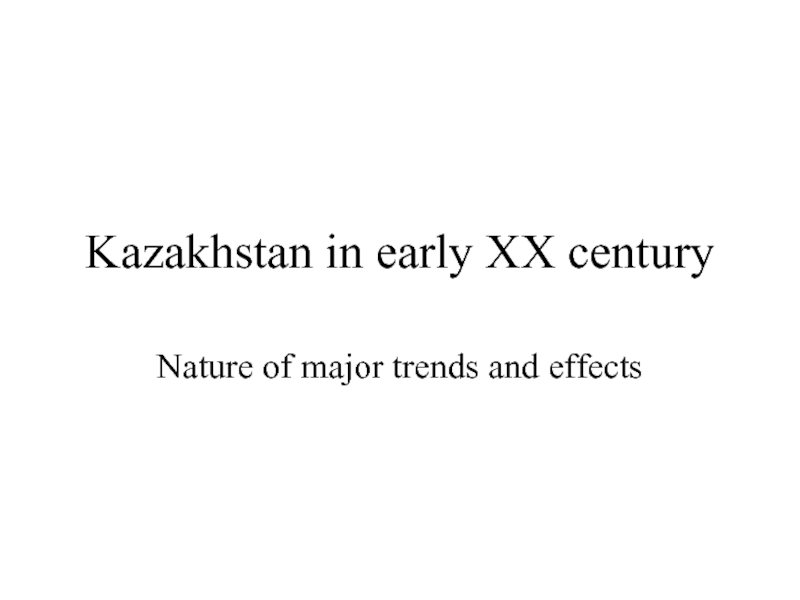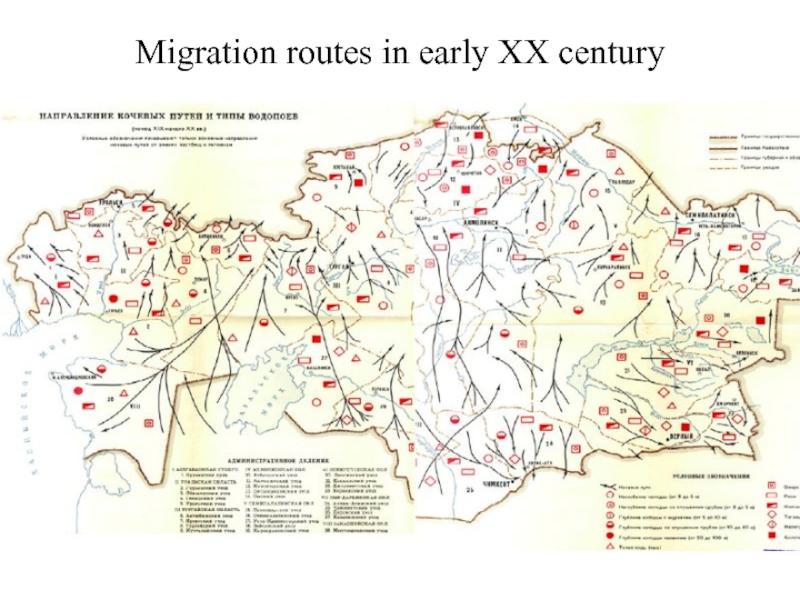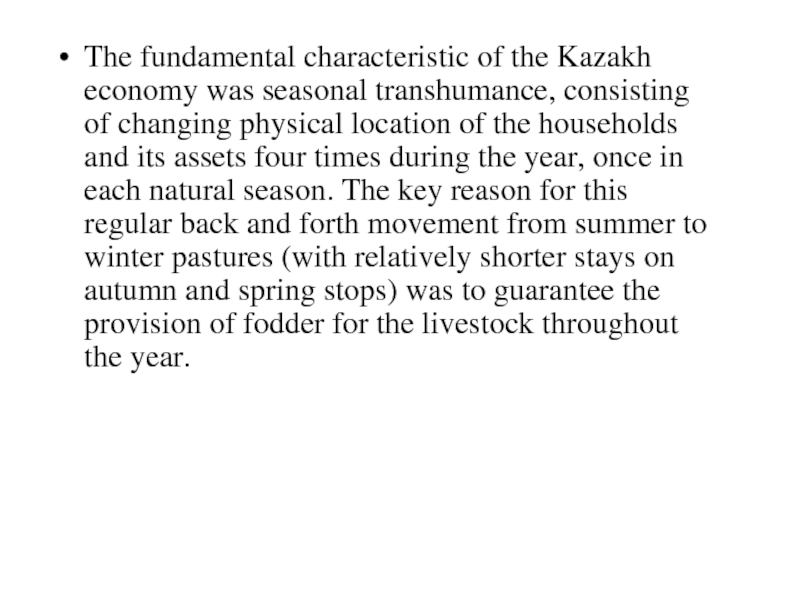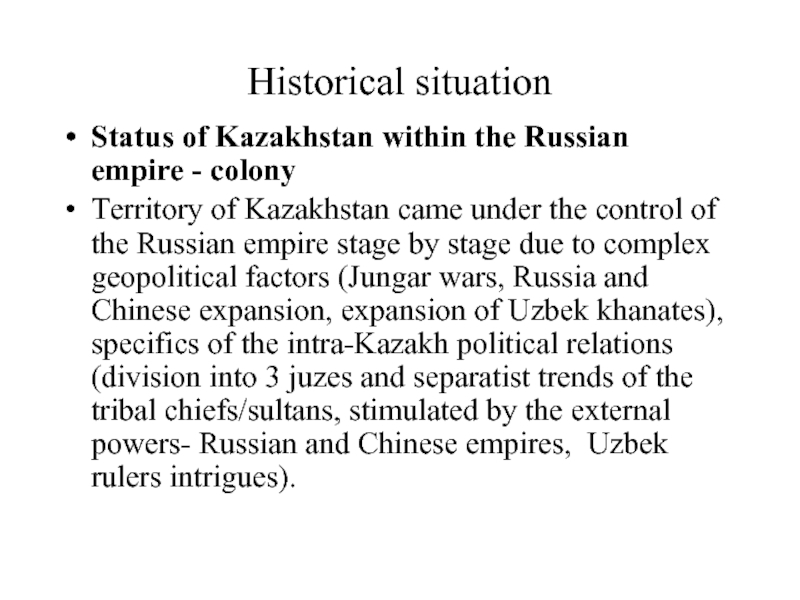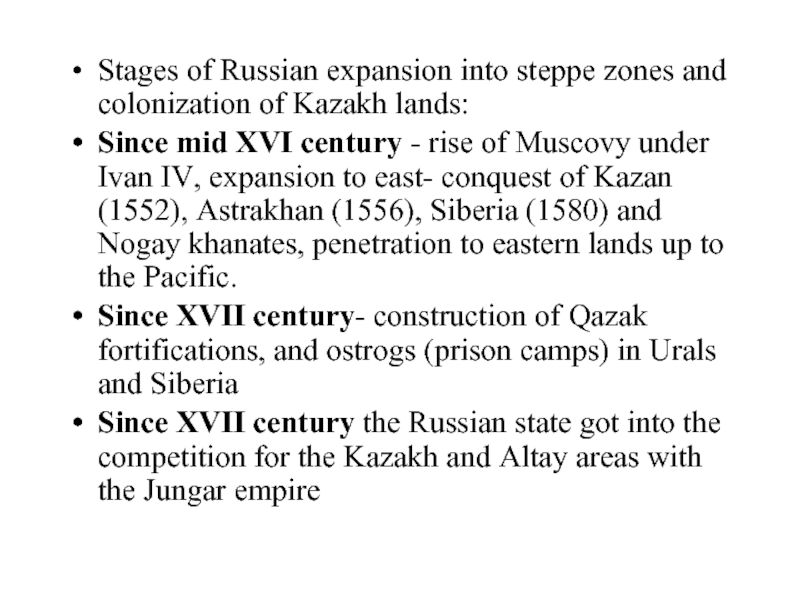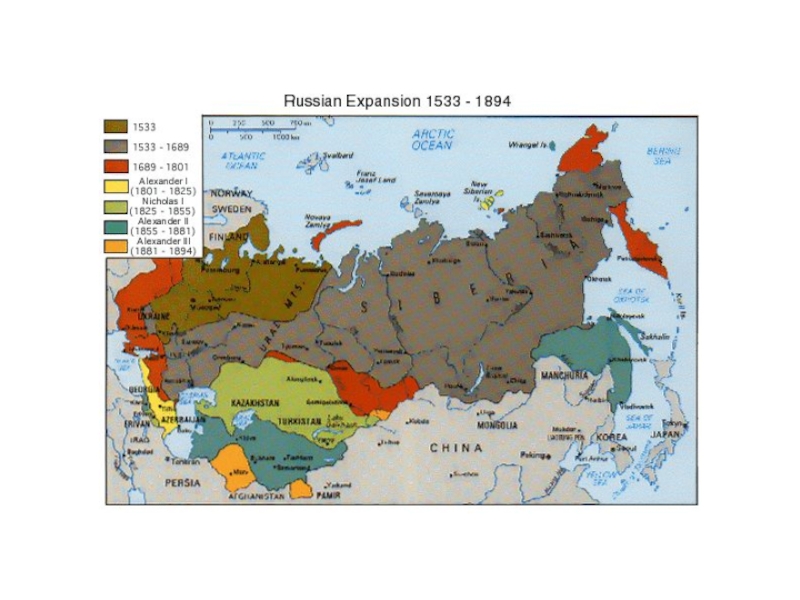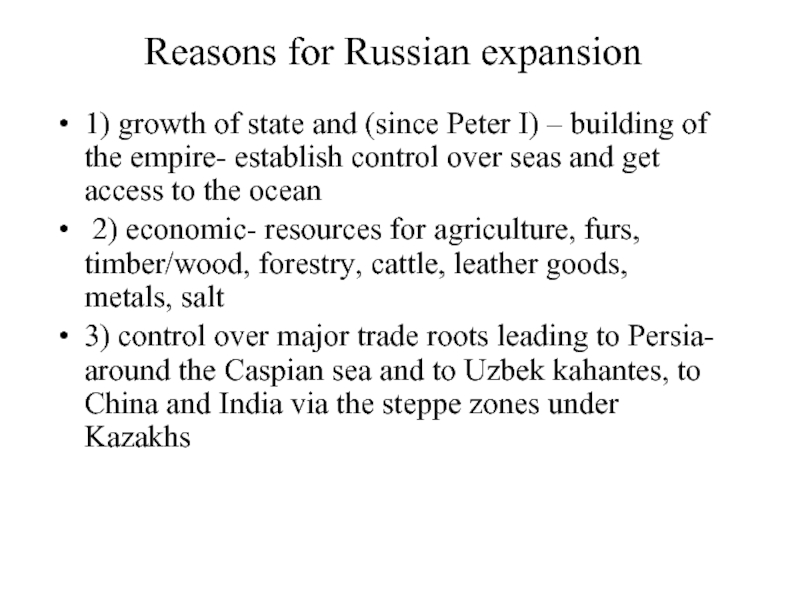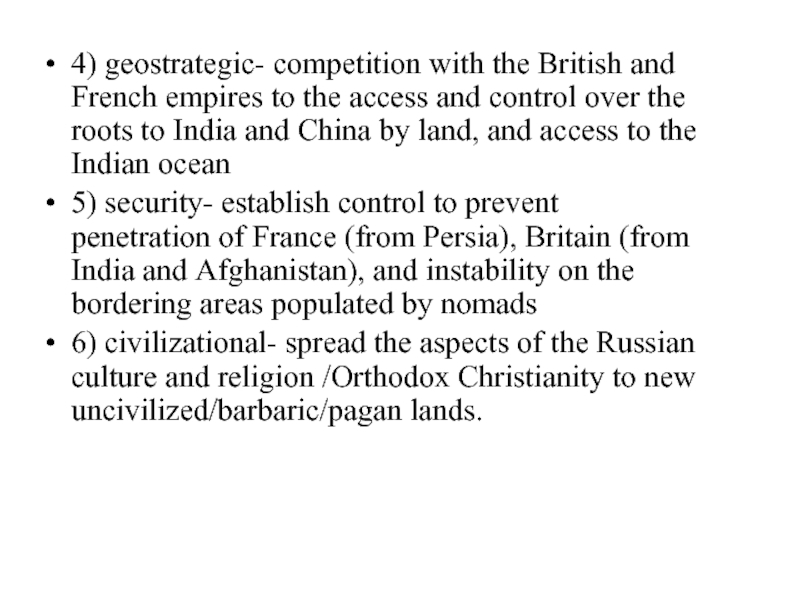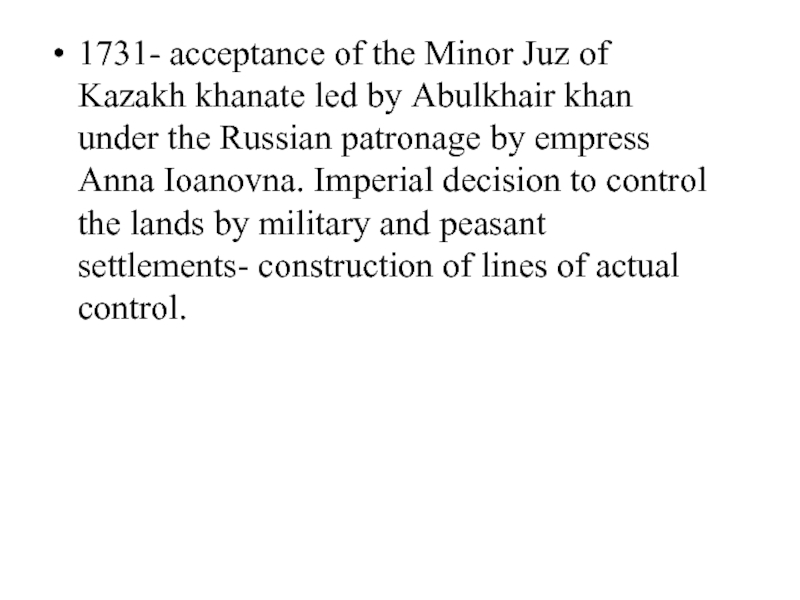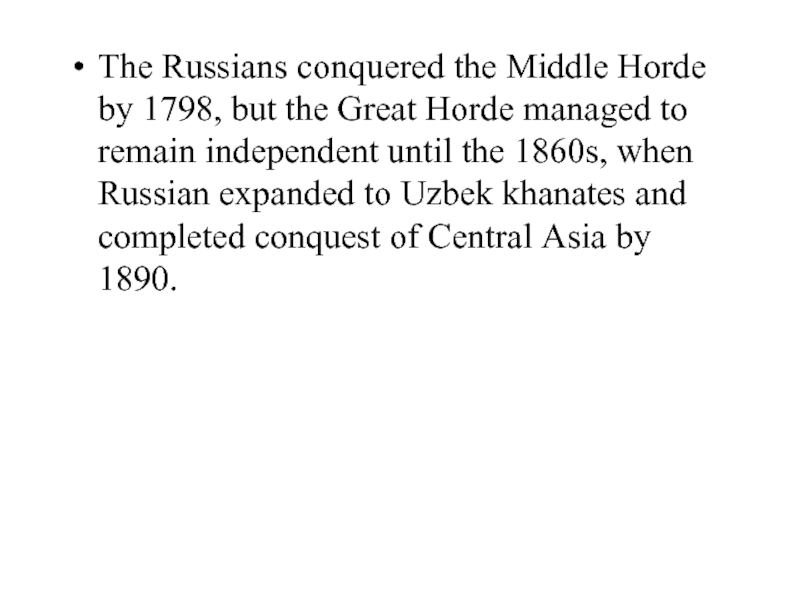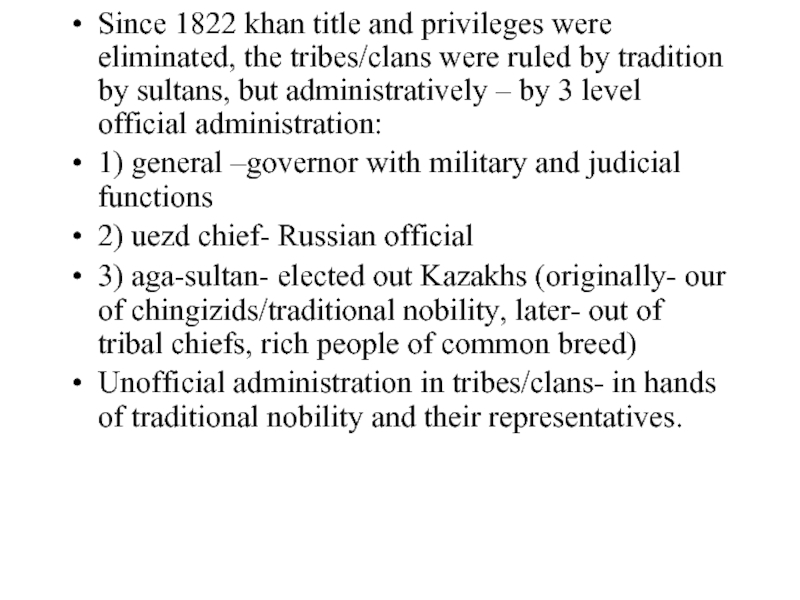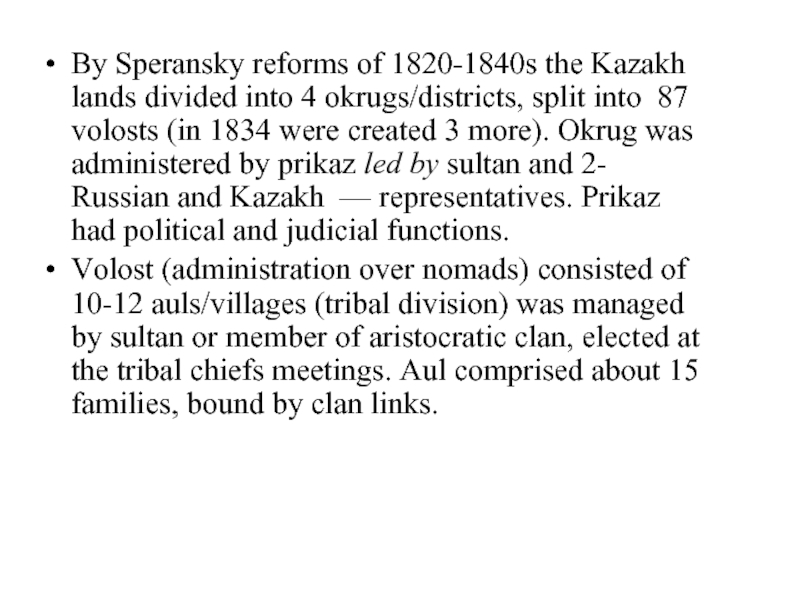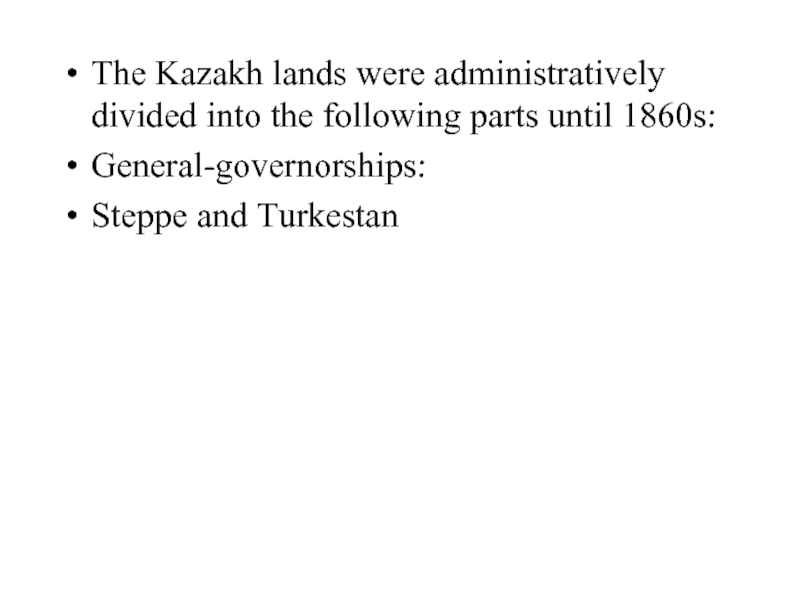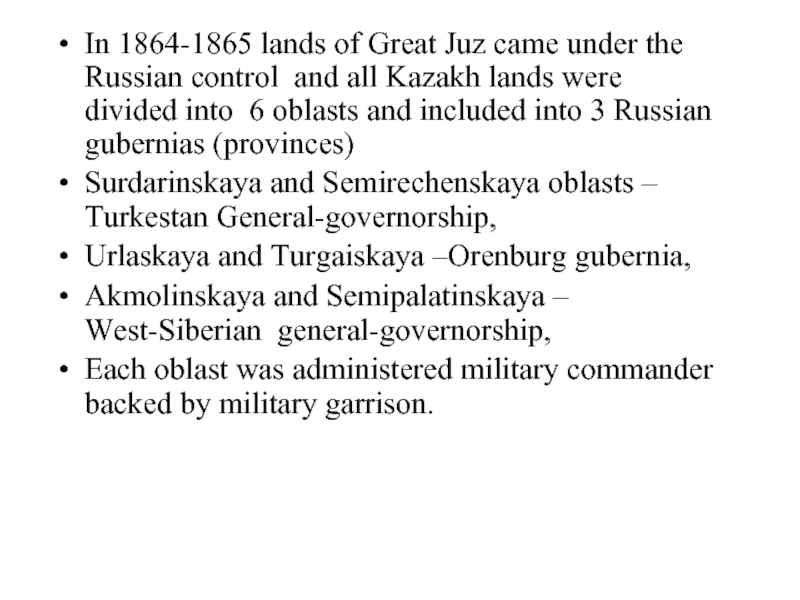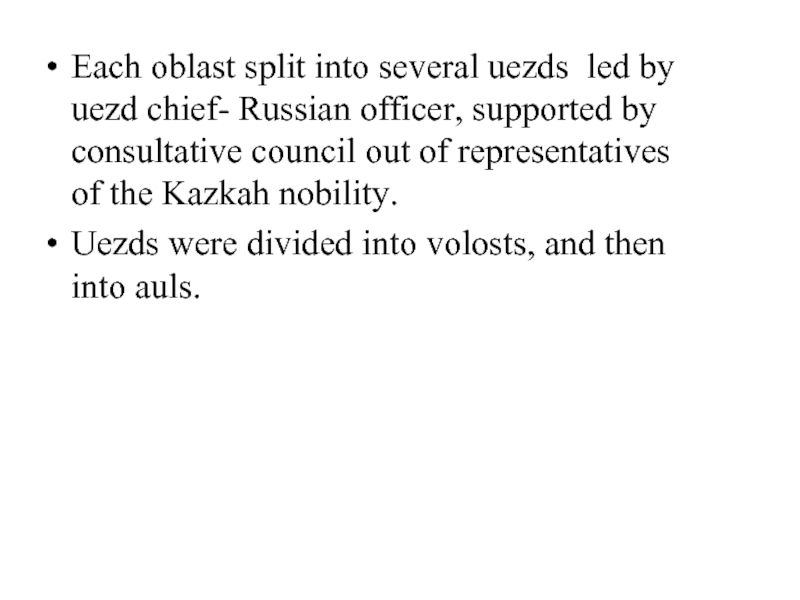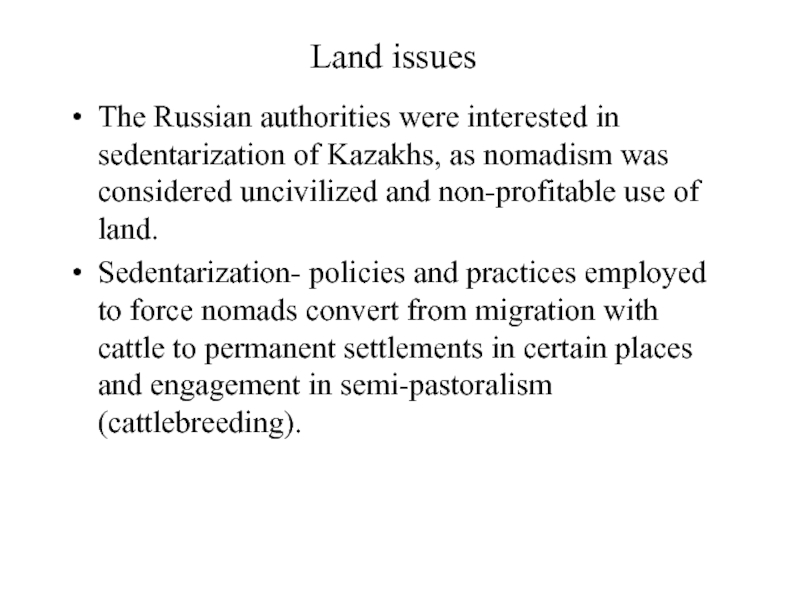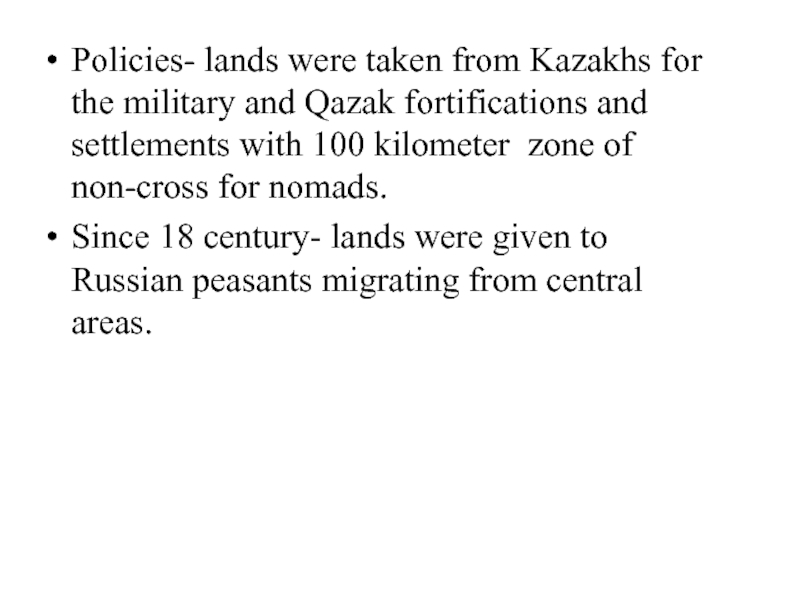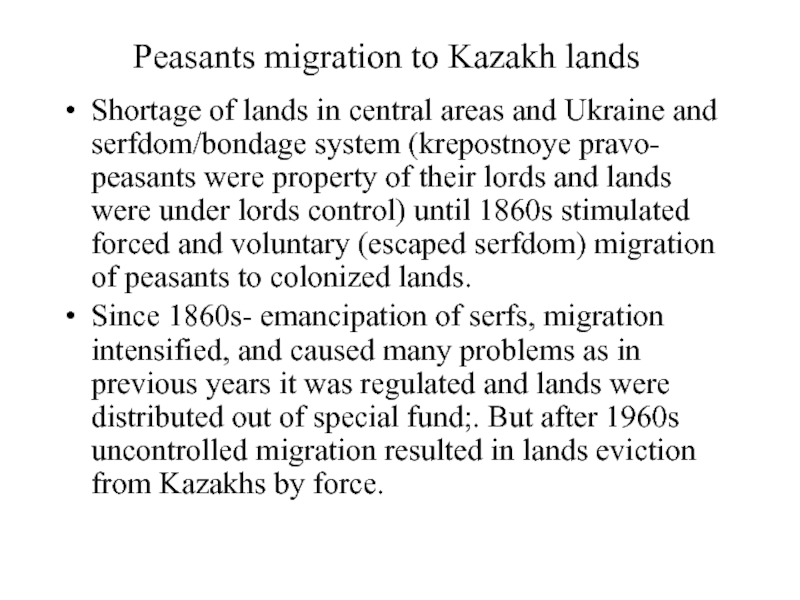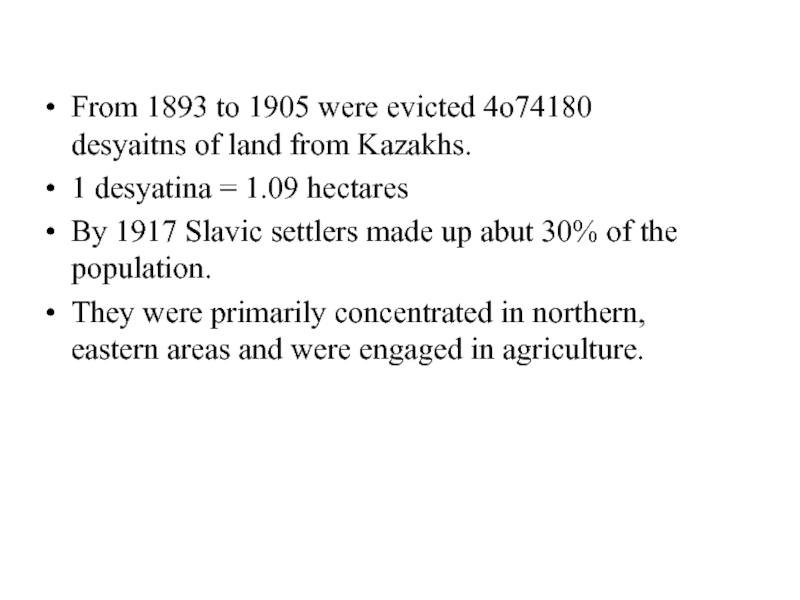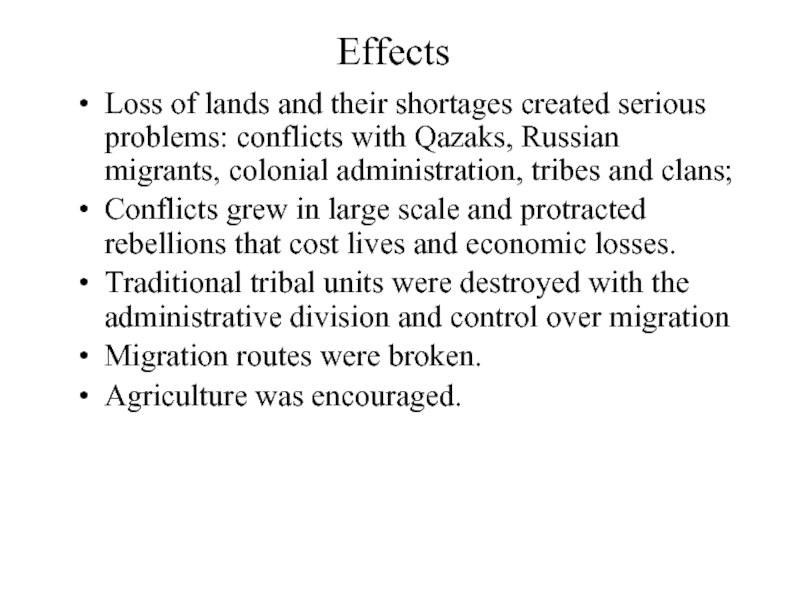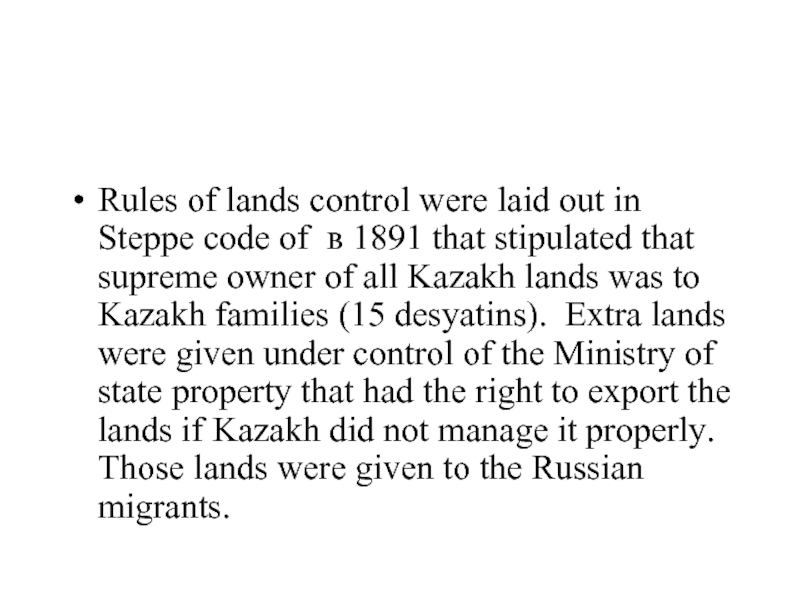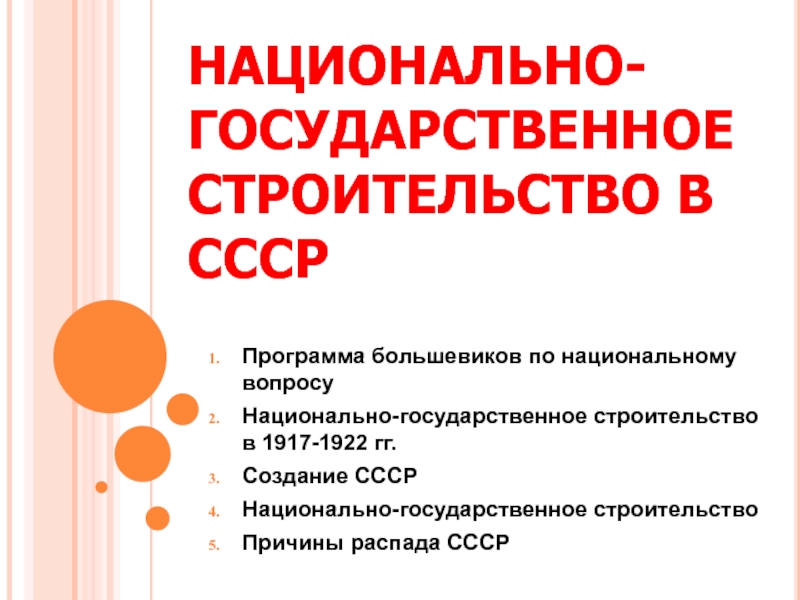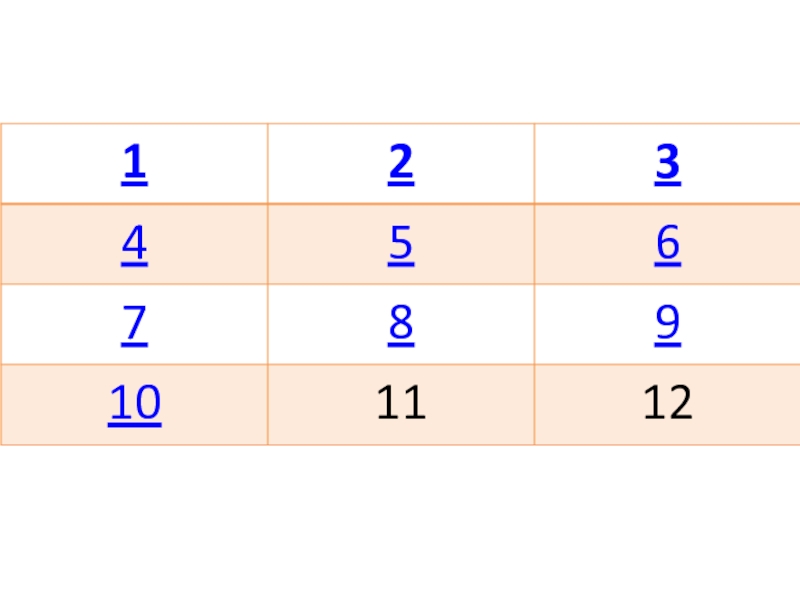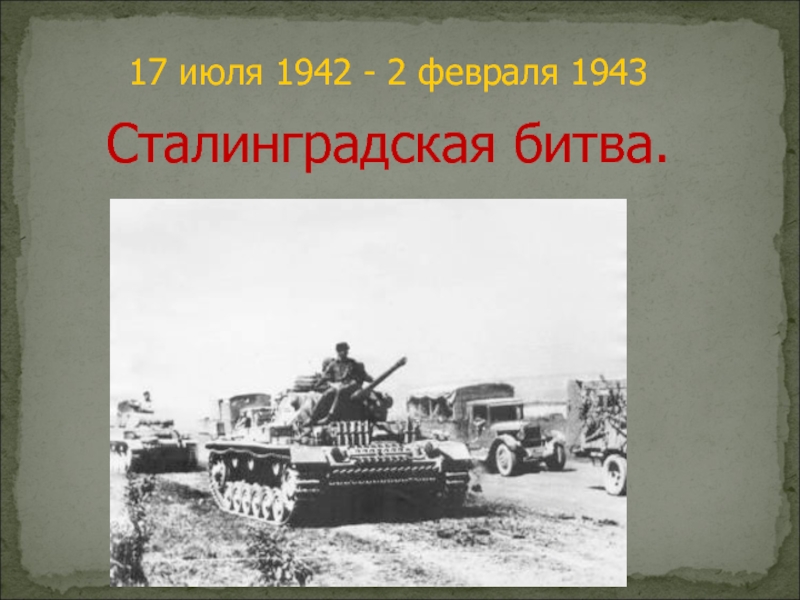- Главная
- Разное
- Дизайн
- Бизнес и предпринимательство
- Аналитика
- Образование
- Развлечения
- Красота и здоровье
- Финансы
- Государство
- Путешествия
- Спорт
- Недвижимость
- Армия
- Графика
- Культурология
- Еда и кулинария
- Лингвистика
- Английский язык
- Астрономия
- Алгебра
- Биология
- География
- Детские презентации
- Информатика
- История
- Литература
- Маркетинг
- Математика
- Медицина
- Менеджмент
- Музыка
- МХК
- Немецкий язык
- ОБЖ
- Обществознание
- Окружающий мир
- Педагогика
- Русский язык
- Технология
- Физика
- Философия
- Химия
- Шаблоны, картинки для презентаций
- Экология
- Экономика
- Юриспруденция
Kazakhstan in early XX century презентация
Содержание
- 1. Kazakhstan in early XX century
- 2. Population By census of late XIX
- 3. Migration routes in early XX century
- 4. The fundamental characteristic of the Kazakh economy
- 5. Historical situation Status of Kazakhstan within
- 6. Stages of Russian expansion into steppe zones
- 8. Reasons for Russian expansion 1) growth of
- 9. 4) geostrategic- competition with the British and
- 10. 1731- acceptance of the Minor Juz of
- 11. The Russians conquered the Middle Horde by
- 12. In 1863 Russian Empire elaborated a new
- 13. Russian administration over Kazakh lands The Kazakh
- 14. Since 1822 khan title and privileges were
- 15. By Speransky reforms of 1820-1840s the Kazakh
- 16. The Kazakh lands were administratively divided into
- 17. In 1864-1865 lands of Great Juz came
- 18. Each oblast split into several uezds led
- 19. Land issues The Russian authorities were
- 20. Policies- lands were taken from Kazakhs for
- 21. Peasants migration to Kazakh lands Shortage
- 22. From 1893 to 1905 were evicted
- 23. Effects Loss of lands and their
- 24. Rules of lands control were laid out
Слайд 2Population
By census of late XIX century population on the territory
of Kazakhstan was were 41447,7 thous. Kazakhs made up 3881.8 thous.
They were nomads, engaged in seasonal nomadic cattlebreeding.
Way of life and social structure were nomadic- clan/jus hierarchy.
Economic life based on seasonal migration with cattle (horse, sheep) . Pasturelands were divided between 3 juzes, inside them- tribal groupings. Access to pasturelands (winter, spring, summer and fall) in tribal group depended on position and status of family.
They were nomads, engaged in seasonal nomadic cattlebreeding.
Way of life and social structure were nomadic- clan/jus hierarchy.
Economic life based on seasonal migration with cattle (horse, sheep) . Pasturelands were divided between 3 juzes, inside them- tribal groupings. Access to pasturelands (winter, spring, summer and fall) in tribal group depended on position and status of family.
Слайд 4The fundamental characteristic of the Kazakh economy was seasonal transhumance, consisting
of changing physical location of the households and its assets four times during the year, once in each natural season. The key reason for this regular back and forth movement from summer to winter pastures (with relatively shorter stays on autumn and spring stops) was to guarantee the provision of fodder for the livestock throughout the year.
Слайд 5Historical situation
Status of Kazakhstan within the Russian empire - colony
Territory
of Kazakhstan came under the control of the Russian empire stage by stage due to complex geopolitical factors (Jungar wars, Russia and Chinese expansion, expansion of Uzbek khanates), specifics of the intra-Kazakh political relations (division into 3 juzes and separatist trends of the tribal chiefs/sultans, stimulated by the external powers- Russian and Chinese empires, Uzbek rulers intrigues).
Слайд 6Stages of Russian expansion into steppe zones and colonization of Kazakh
lands:
Since mid XVI century - rise of Muscovy under Ivan IV, expansion to east- conquest of Kazan (1552), Astrakhan (1556), Siberia (1580) and Nogay khanates, penetration to eastern lands up to the Pacific.
Since XVII century- construction of Qazak fortifications, and ostrogs (prison camps) in Urals and Siberia
Since XVII century the Russian state got into the competition for the Kazakh and Altay areas with the Jungar empire
Since mid XVI century - rise of Muscovy under Ivan IV, expansion to east- conquest of Kazan (1552), Astrakhan (1556), Siberia (1580) and Nogay khanates, penetration to eastern lands up to the Pacific.
Since XVII century- construction of Qazak fortifications, and ostrogs (prison camps) in Urals and Siberia
Since XVII century the Russian state got into the competition for the Kazakh and Altay areas with the Jungar empire
Слайд 8Reasons for Russian expansion
1) growth of state and (since Peter I)
– building of the empire- establish control over seas and get access to the ocean
2) economic- resources for agriculture, furs, timber/wood, forestry, cattle, leather goods, metals, salt
3) control over major trade roots leading to Persia- around the Caspian sea and to Uzbek kahantes, to China and India via the steppe zones under Kazakhs
2) economic- resources for agriculture, furs, timber/wood, forestry, cattle, leather goods, metals, salt
3) control over major trade roots leading to Persia- around the Caspian sea and to Uzbek kahantes, to China and India via the steppe zones under Kazakhs
Слайд 94) geostrategic- competition with the British and French empires to the
access and control over the roots to India and China by land, and access to the Indian ocean
5) security- establish control to prevent penetration of France (from Persia), Britain (from India and Afghanistan), and instability on the bordering areas populated by nomads
6) civilizational- spread the aspects of the Russian culture and religion /Orthodox Christianity to new uncivilized/barbaric/pagan lands.
5) security- establish control to prevent penetration of France (from Persia), Britain (from India and Afghanistan), and instability on the bordering areas populated by nomads
6) civilizational- spread the aspects of the Russian culture and religion /Orthodox Christianity to new uncivilized/barbaric/pagan lands.
Слайд 101731- acceptance of the Minor Juz of Kazakh khanate led by
Abulkhair khan under the Russian patronage by empress Anna Ioanovna. Imperial decision to control the lands by military and peasant settlements- construction of lines of actual control.
Слайд 11The Russians conquered the Middle Horde by 1798, but the Great
Horde managed to remain independent until the 1860s, when Russian expanded to Uzbek khanates and completed conquest of Central Asia by 1890.
Слайд 12In 1863 Russian Empire elaborated a new imperial policy, announced in
the , asserting the right to annex "troublesome" areas on the empire's borders. This policy led immediately to the Russian conquest of the rest of Central Asia and the creation of two administrative districts, the General-Gubernatorstvo (Governor-Generalship) of Russian Turkestan and that of the Steppe. Most of present-day Kazakhstan was in the Steppe District, and parts of present-day southern Kazakhstan, including Almaty (Verny), were in the Governor-Generalship.
Слайд 13Russian administration over Kazakh lands
The Kazakh lands got Russian vassalage/protectorate and
enjoyed self-rule until reforms of 1822: khans out of the chingizids, sultans, khan council, maslikhats, meetings of tribal chiefs, tribal chiefs, aqsaqals.
Слайд 14Since 1822 khan title and privileges were eliminated, the tribes/clans were
ruled by tradition by sultans, but administratively – by 3 level official administration:
1) general –governor with military and judicial functions
2) uezd chief- Russian official
3) aga-sultan- elected out Kazakhs (originally- our of chingizids/traditional nobility, later- out of tribal chiefs, rich people of common breed)
Unofficial administration in tribes/clans- in hands of traditional nobility and their representatives.
1) general –governor with military and judicial functions
2) uezd chief- Russian official
3) aga-sultan- elected out Kazakhs (originally- our of chingizids/traditional nobility, later- out of tribal chiefs, rich people of common breed)
Unofficial administration in tribes/clans- in hands of traditional nobility and their representatives.
Слайд 15By Speransky reforms of 1820-1840s the Kazakh lands divided into 4
okrugs/districts, split into 87 volosts (in 1834 were created 3 more). Okrug was administered by prikaz led by sultan and 2- Russian and Kazakh — representatives. Prikaz had political and judicial functions.
Volost (administration over nomads) consisted of 10-12 auls/villages (tribal division) was managed by sultan or member of aristocratic clan, elected at the tribal chiefs meetings. Aul comprised about 15 families, bound by clan links.
Volost (administration over nomads) consisted of 10-12 auls/villages (tribal division) was managed by sultan or member of aristocratic clan, elected at the tribal chiefs meetings. Aul comprised about 15 families, bound by clan links.
Слайд 16The Kazakh lands were administratively divided into the following parts until
1860s:
General-governorships:
Steppe and Turkestan
General-governorships:
Steppe and Turkestan
Слайд 17In 1864-1865 lands of Great Juz came under the Russian control
and all Kazakh lands were divided into 6 oblasts and included into 3 Russian gubernias (provinces)
Surdarinskaya and Semirechenskaya oblasts – Turkestan General-governorship,
Urlaskaya and Turgaiskaya –Orenburg gubernia,
Akmolinskaya and Semipalatinskaya – West-Siberian general-governorship,
Each oblast was administered military commander backed by military garrison.
Surdarinskaya and Semirechenskaya oblasts – Turkestan General-governorship,
Urlaskaya and Turgaiskaya –Orenburg gubernia,
Akmolinskaya and Semipalatinskaya – West-Siberian general-governorship,
Each oblast was administered military commander backed by military garrison.
Слайд 18Each oblast split into several uezds led by uezd chief- Russian
officer, supported by consultative council out of representatives of the Kazkah nobility.
Uezds were divided into volosts, and then into auls.
Uezds were divided into volosts, and then into auls.
Слайд 19Land issues
The Russian authorities were interested in sedentarization of Kazakhs,
as nomadism was considered uncivilized and non-profitable use of land.
Sedentarization- policies and practices employed to force nomads convert from migration with cattle to permanent settlements in certain places and engagement in semi-pastoralism (cattlebreeding).
Sedentarization- policies and practices employed to force nomads convert from migration with cattle to permanent settlements in certain places and engagement in semi-pastoralism (cattlebreeding).
Слайд 20Policies- lands were taken from Kazakhs for the military and Qazak
fortifications and settlements with 100 kilometer zone of non-cross for nomads.
Since 18 century- lands were given to Russian peasants migrating from central areas.
Since 18 century- lands were given to Russian peasants migrating from central areas.
Слайд 21Peasants migration to Kazakh lands
Shortage of lands in central areas
and Ukraine and serfdom/bondage system (krepostnoye pravo- peasants were property of their lords and lands were under lords control) until 1860s stimulated forced and voluntary (escaped serfdom) migration of peasants to colonized lands.
Since 1860s- emancipation of serfs, migration intensified, and caused many problems as in previous years it was regulated and lands were distributed out of special fund;. But after 1960s uncontrolled migration resulted in lands eviction from Kazakhs by force.
Since 1860s- emancipation of serfs, migration intensified, and caused many problems as in previous years it was regulated and lands were distributed out of special fund;. But after 1960s uncontrolled migration resulted in lands eviction from Kazakhs by force.
Слайд 22
From 1893 to 1905 were evicted 4o74180 desyaitns of land from
Kazakhs.
1 desyatina = 1.09 hectares
By 1917 Slavic settlers made up abut 30% of the population.
They were primarily concentrated in northern, eastern areas and were engaged in agriculture.
1 desyatina = 1.09 hectares
By 1917 Slavic settlers made up abut 30% of the population.
They were primarily concentrated in northern, eastern areas and were engaged in agriculture.
Слайд 23Effects
Loss of lands and their shortages created serious problems: conflicts
with Qazaks, Russian migrants, colonial administration, tribes and clans;
Conflicts grew in large scale and protracted rebellions that cost lives and economic losses.
Traditional tribal units were destroyed with the administrative division and control over migration
Migration routes were broken.
Agriculture was encouraged.
Conflicts grew in large scale and protracted rebellions that cost lives and economic losses.
Traditional tribal units were destroyed with the administrative division and control over migration
Migration routes were broken.
Agriculture was encouraged.
Слайд 24Rules of lands control were laid out in Steppe code of
в 1891 that stipulated that supreme owner of all Kazakh lands was to Kazakh families (15 desyatins). Extra lands were given under control of the Ministry of state property that had the right to export the lands if Kazakh did not manage it properly. Those lands were given to the Russian migrants.
